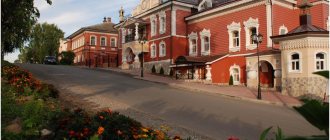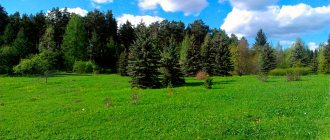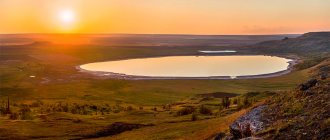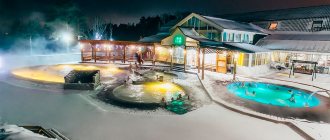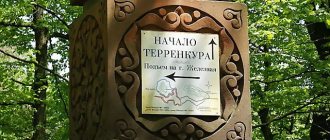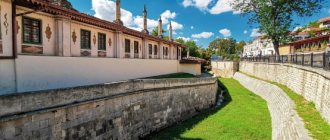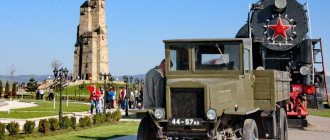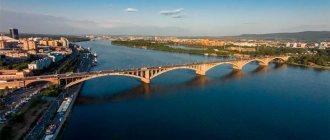Ryazan is a fairly large regional center and it is not possible to get around all the sights (and especially visit museums) in one day. But following our route: visiting the Ryazan Kremlin, Cathedral Park, Cathedral Square, walking along the main streets, you will get a complete picture of the city and will probably want to come back here to see other sights of Ryazan!
Ryazan Kremlin
The Ryazan Kremlin is the oldest part of the city, an architectural monument of federal significance and one of the oldest museums in Russia. The main attraction of Ryazan, which must be visited first.
On the territory of the Ryazan Kremlin
Glebov Bridge
Today the Glebovsky Bridge simply connects the territory of the Cathedral Park with the Kremlin, but at one time it also successfully performed military and defensive functions. During sieges, the bridge rose to the walls, thereby blocking the path of the attackers.
Cathedral bell tower
The cathedral bell tower , 83.2 meters high, is one of the twenty tallest bell towers in Russia and is one of the tallest buildings in the Ryazan region (2016).
Glebov Bridge and Cathedral Bell Tower in Ryazan
Built between 1797 and 1840 in the classicist style according to the designs of three different architects: I. F. Russko, K. A. Ton and N. I. Voronikhin. At the top of the bell tower is a gilded 25-meter spire. Despite the fact that its creation took about 50 years, the bell tower has no equal in Russia for its perfectly found proportions, purity and severity of style.
Assumption Cathedral
The Assumption Cathedral is the main attraction of the Ryazan Kremlin, one of the most significant temples of the Ryazan land, built in the “Naryshkin” Baroque style by the architect Yakov Grigorievich Bukhvostov in 1693-1699. When creating it, the architect relied on the model of the Assumption Cathedral of the Moscow Kremlin. This is one of the most majestic buildings of its time and the most significant monuments of the “Naryshkin style”.
The Assumption Cathedral has reached us modified: the white stone parapet has disappeared, the shape of the roof has been changed.
The structure is very clear and harmonious in composition, decorated with a wonderful white stone “pattern”: leaves, flowers, grapes, but without repeating details.
The main decoration of the interior of the cathedral is the seven-tiered iconostasis of the 17th century, 27 meters high. In 1701, the iconostasis was gilded by Moscow master gilders. The icons for the iconostasis were painted by the icon painter Nikolai Solomonov and his assistants.
Nativity of Christ Cathedral
Along with the Assumption Cathedral, the Church of the Nativity of Christ is one of the main churches of the Ryazan Metropolis.
Founded at the end of the 14th century by Grand Duke Oleg of Ryazan, it is one of the oldest buildings in the Ryazan region and the first stone building on the territory of the Kremlin.
Initially, the temple bore the name of the Assumption Cathedral, but after the construction of a new building it was renamed the Nativity of Christ.
The cathedral was rebuilt several times and the version that emerged at the beginning of the 19th century has survived to this day. The temple then, thanks to the efforts of the architect Stephenhagen, received treatment in the spirit of “Russian-Byzantine architecture”.
Church of the Epiphany
The Church of the Epiphany is a five-domed white stone church built in the mid-17th century on the site of a 16th-century church destroyed during a fire.
It is an elegant temple, with five gilded domes, a refectory and a tented bell tower.
The tented bell tower originally had 6 bells. These bells were removed after the 1917 revolution and disappeared without a trace.
Cathedral of the Archangel
A monument of ancient Russian architecture of the 15th - 17th centuries, one of the oldest buildings in the Ryazan Kremlin. It is a four-pillar, cross-domed, single-domed temple with three apses and three entrances.
The former princely house church and at the same time the tomb of Ryazan bishops (22 burials), including the famous religious and public figure, associate of Peter the Great, Stefan Yavorsky.
Consistory Corps
The consistory building is the main administrative building of the Ryazan diocese, the storage place for the church archives. Also at one time the court chamber was located here.
The author of the project is architect Yu.K. Ershov, under whose leadership many other Kremlin buildings appeared.
It is a monument of civil architecture of the mid-17th century.
The building houses three permanent museum exhibitions, by visiting which visitors will be able to plunge into the ancient history of the Ryazan Land (exhibition “Before our era...”). On the second floor, fragments of paintings with very rare scenes - court scenes - have been preserved.
Oleg's Palace
Oleg's Palace is an architectural monument of the 17th – 19th centuries, the largest civilian building in the Kremlin, with an area of 2530 sq. m.
The building with colored orange trim, small windows and a white stone porch is connected by a small bridge from the galleries of the Assumption Cathedral on the second floor.
Through the arch of the stone gallery connecting the palace with the Singing Building, you can exit to the embankment of the Trubezh River.
Previously, the residential chambers of Ryazan bishops were located here. The building housed their home church, fraternal cells and economic services.
Today, the Oleg Palace houses expositions and exhibitions of the museum-reserve, and stock collections are stored.
Singing Corps
The singing building is a monument of civil architecture of the mid-17th century, representing a two-story rectangular building, built according to the design of architect Yu.K. Ershova. The porch, made in the best traditions of ancient Russian architecture, gives it a special elegance.
The building received such an unusual name due to the fact that singers’ rehearsals were held here at one time. But the purpose of the building was completely different: there were apartments for the treasurer and housekeeper who served the bishop.
Today, inside the building there is an exhibition of the museum “According to Grandfather’s Custom,” which tells about the everyday life and holidays of the Russian people.
Singing corps in the Ryazan Kremlin (center, background)
Home for the parable
A stone and wooden building in which the employees of the Temple of the Holy Spirit were housed. One of the newest buildings of the Ryazan Kremlin was built in 1910 according to the design of the provincial architect Anton Semenovich Kandinov. In common parlance, the house for the parable is called the “priest’s house.”
Church of the Holy Spirit
Church of the Holy Spirit - A genuine example of an ancient tented church, the only building of the Dukhovsky Monastery of the 15th century that has survived to this day. In 1864, on the site of the dismantled original bell tower, a new, three-tier hipped belfry was built according to the design of the architect I.V. Stopycheva.
The church has two high tents, the quadrangle is decorated with a pile of beautiful kokoshniks. Unlike other Kremlin buildings, the external parts of the Spiritual Church are not overloaded with decorative elements.
Mob Hotel (Cash desk, souvenirs)
The Motel Hotel is a two-story stone building dating back to the 17th century, built according to the design of the architect N. Ustinov. Consists of fourteen isolated rooms. Served as barns for storing grain and other supplies, later converted into a hotel for passing Chernets monks.
Today, in the building of the Mob Hotel there are two museum exhibitions: “Russian Army” and “Pereyaslavl Ryazan. Archeology reveals secrets." The entrance and ticket office are located in the left wing. You can also buy souvenirs there.
Museum administration and Free WC
In the eastern part of the Kremlin there is an administrative building and a completely free toilet. The map of the Ryazan Kremlin will help you.
Transfiguration Cathedral
The tall, square, single-domed Spaso-Preobrazhensky Cathedral was built in 1702 by merchant M.F. Nemchinov under the rector of this monastery, Archimandrite Lev. It had a five-tiered iconostasis in the Baroque style.
The windows of the cathedral are decorated with carved white stone frames of the “Naryshkin” style and belts of highly artistic polychrome tiles.
Hotel of the nobility
The Hotel of the Nobility is located in the southern part of the Ryazan Kremlin. It is a monument of civil architecture of the 17th-19th centuries. It consists of two buildings, which not long ago housed apartments for ordinary citizens. It is known that the future writer Konstantin Mikhailovich Simonov once lived in the hotel with his parents.
On the ground floor of the “Hotel of the Nobility”, significant parts of the walls of ancient cells of the 17th century have been preserved. The building consists of two buildings of different periods from the 18th-19th centuries, which at the beginning of the 20th century. were connected by a church in the name of John the Theologian.
By going around the hotel you can go to the ancient defensive rampart.
A two-story building - a hotel for the nobility, a temple with one blue dome - the Transfiguration Cathedral.
Kremlin Val
The Kremlin hill is of natural origin, surrounded on three sides by two rivers - Trubezh and Lybid. On the fourth side there is a dry ditch dug by city residents in the 13th century to defend the city. The ditch was filled with water, thereby connecting both rivers, and a continuous water ring was formed around the hill.
Length of the shaft: 290 meters, modern height: 18 meters from the outer bottom and 8 meters from the side of Verkhneilyinskaya street near the Kremlin. Until the 18th century, defensive walls and towers were located on its top. The other two ramparts were located on the territory of a fortified fort adjacent to the Kremlin. They were completely torn down during the reconstruction of the city in the 18th–19th centuries.
From the top of the rampart there are magnificent views of the main attraction of Ryazan - the entire ensemble of the Ryazan Kremlin.
Although the view of the city from the rampart is not at all picturesque.
Sights of Ryazan - photos with descriptions
Ryazan Kremlin
The main and most obvious attraction of the city is the Ryazan Kremlin, consisting of many buildings mainly dating from the seventeenth century. The earlier buildings, unfortunately, have not survived to this day.
Even on the approach to the Kremlin, the tourist’s gaze opens to a view of the Cathedral Bell Tower, to which a well-kept alley with benches and original lanterns on both sides leads. The cathedral bell tower was built in the nineteenth century on the site of the former Kremlin tower, the height of the bell tower is 83.2 meters, the top of the bell tower is crowned with a gilded spire.
Immediately behind the bell tower stands the Assumption Cathedral, built at the end of the seventeenth century. The cathedral itself is built of red brick and in general has a banal and nondescript appearance, but the white stucco molding that adorns the walls and window openings gives the cathedral a certain zest.
Ryazan Kremlin. Assumption Cathedral
Walking further, deep into the Kremlin territory, the tourist can admire the Transfiguration Cathedral, the Archangel Cathedral and the Church of the Epiphany.
The Kremlin's bishop's courtyard is interesting for its seventeenth-century buildings; here you can see the “Oleg's Palace”, the Consistory building made of white stone, the Singing building made in the same manner, as well as the carriage house and stables. Currently, these buildings house exhibition halls and several museums.
Every guidebook, any website about tourism or about this city, sends to the holy of holies the Kremlin and the village of Konstantinovo, the father's home of Sergei Yesenin. These places are certainly worth attention, the beauty of the view, many museums, good infrastructure around, there is nothing to argue with, but I would like to consider Ryazan from the other side.
Let's turn around. Gray, crowded minibuses and dirt? Not at all. Ancient houses in the very center of the city! Masterpieces of architecture of the 18th – 19th centuries! Where? Yes, here they are.
Cathedral Park in Ryazan
Leaving the territory of the Ryazan Kremlin along the Glebovsky Bridge, you can get to the large Cathedral Park, where there is a monument to Sergei Yesenin and the colorful Church of the Transfiguration of the Savior on the Yar.
Views of the Kremlin from Cathedral Park.
Cathedral Park is a pleasant place for walking with beautiful views of Ryazan rivers and churches.
Ryazan souvenirs are sold in the park, and tourists are given horse rides.
Stele in memory of Ryazan soldiers who participated in the Patriotic War of 1812
Stele in memory of Ryazan soldiers who participated in the Patriotic War of 1812. 23 thousand Ryazan residents took part in the Patriotic War, 89 of them were awarded high awards for courage and valor shown in battle.
Church of the Savior on Yara
The Church of the Savior on the Yara is located on the territory of the ancient Ostrog in the western part of the cathedral park.
The existing stone church with five domes and a hipped bell tower was erected in 1695 by the steward Ivan Ivanovich Verderevensky. The bell tower of the temple is built in the form of a pillar, covered with an octagonal tent.
The elegant five-domed church is deservedly considered one of the best in Ryazan. It is also the oldest operating temple in the city, where church services are regularly held.
Ryazan Cossacks, who took an active part in the restoration of the sanctuary after the revolution and communist repressions against the church, erected a worship cross in front of the entrance, dedicated to the 555th anniversary of the Ryazan Cossacks.
Monument to Sergei Yesenin in Ryazan
On the high bank of the Trubezh River near the Church of the Savior on the Yar there is a sculpture dedicated to Sergei Yesenin. The great poet was born and raised here, in the Ryazan region, in his works he more than once sang the beauty of Russian nature, inspired by the views of the Ryazan region, the Oka expanses of his native village of Konstantinovo.
The monument was opened on October 2, 1975 on the occasion of the 80th anniversary of the birth of the talented writer. The monument is made of bronze.
Streets of Ryazan
Leaving the Kremlin and the Cathedral Park, tourists find themselves on Sobornaya Street.
Sobornaya Street
Sobornaya Street is considered one of the most beautiful in Ryazan due to its preserved pre-revolutionary houses.
Leaving the park through the central entrance you can see the monument to Grand Duke Oleg Ryazansky. Installed in 2007 under the leadership of the President of the Russian Academy of Arts Zurab Tsereteli.
The reign of the Grand Duke is the era of the greatest power of the Ryazan Principality. During the years of his reign, Oleg Ryazansky became famous not only as a first-class warrior, but also as an excellent diplomat.
The main department of the Central Bank of the Russian Federation for the Ryazan region is located in an old Soviet building.
Construction of the museum center of the Ryazan Historical and Architectural Museum-Reserve is in full swing. The work is expected to be completed in 2022.
Trolleybus traffic is well developed in Ryazan: the “mustached” routes essentially cover the entire city. But the Ryazan tram ceased to exist in 2010.
In Ryazan you can still ride the buses of our childhood - the Ikarus 280 model.
Minibus taxis are the scourge of almost all poor regional centers of Russia, to which Ryazan also belongs.
Let the image of a red pedestrian hit at a Ryazan traffic light be a warning for you.
We continue to walk along Sobornaya. On the left side is the Ryazan City Library named after. Gorky. One of the oldest libraries in Russia, occupying a leading position among regional libraries in the country. Founded on January 2 (14), 1858, it is to this day a major scientific, informational, educational, and methodological center, which is visited annually by tens of thousands of readers.
In 1968, on the occasion of the 100th anniversary of Gorky’s birth, a stele with a bas-relief of the writer was unveiled near the library building.
Postal Street
The next attraction of Ryazan on the course: the pedestrian street Pochtovaya. To get there, turn onto Lenin Street and follow to the postal square with the monument to Evpatiy Kolovrat.
A very famous person in Ryazan: Ryazan boyar, governor and Russian hero, hero of the Ryazan folk tale of the 13th century, during the invasion of Batu.
Perhaps the most noticeable building on Pochtovaya Street (though in its non-pedestrian part) is the building of the Arbitration Court of the Ryazan Region. The architectural monument was built in 1840 according to the design of the Ryazan provincial architect S.A. Shchetkina. For about a hundred years, a state bank was located here.
Pochtovaya Street in Ryazan is often called Podbelka by local residents (after its previous name “Podbelskogo”). This is a favorite meeting and walking place for city residents. Tourists really have nothing special to do here except go to cafes, of which there are a great many. On the postal street there was no place for the usual Arbat monuments, fountain, zero kilometer, or street musicians.
The abundance of benches and lanterns on the street is pleasing. There is nothing more to brag about.
Lenin Square
Poshtovaya Street ends with Lenin Square with a monument to the leader. It is considered the main square of Ryazan.
The history of this monument is interesting, which was dismantled in 1993 by order of the mayor of the city, putting in its place a cross, which was later replaced with a structure depicting the symbols of Ryazan. Then trolleybus drivers jokingly announced the stop as follows: “Square without Lenin.”
In 1997, by decision of the new city government, the monument was restored to its original form.
Several main streets and the impressive Pervomaisky Avenue originate from the square.
City shopping arcades
The central Lenin Square is decorated with beautiful and elegant shopping arcades, built according to the 1794 design of the provincial architect Ivan Sulakadzev.
Lenin Square was previously known under the names Khlebnaya and Novobazarnaya and was by no means considered the center of the city. They traded bread and flour here. Subsequently, the number of retail outlets increased and the untidy market with wooden temporary buildings needed to be put in order. This is how Ivan Sulakadzev’s Trading Rows project appeared.
The two-story historical buildings are typical for a merchant city. On the ground floor there were shops and shops, and on the second there were residential apartments. In the ensemble of the City Trade (Bread) Rows, only two buildings out of six have survived today.
Currently, Trade Rows have not lost their function: there is a Trade Complex with shops of various types (from clothing to souvenirs), cafes and restaurants.
Next to the shopping arcades, the city administration has built a small park with a fountain.
There is a Russian spirit here, it smells like Russia! Even the buses are named after the epic heroes “Ilya Muromets”.
Memorial to Ryazan residents who fell in local conflicts
In Ryazan they honor the memory of fellow warriors who died in Soviet and post-Soviet times, otherwise they would not have erected such a large-scale memorial!
The complex was built on the square named after Army General V.F. Margelova. The opening took place in June 2000.
The monument to the soldiers is made in the form of a ring on high granite pillars with marble slabs below the ring. The names of 248 Ryazan soldiers who gave their lives on the battlefield, remaining faithful to the oath, are engraved in gold on the slabs.
I want to live so that I can give to my Motherland the last driving impulse of my heart, so that even when I die I can say that I am dying for the Motherland.
M. Jalil
A little further there is a monument to Vasily Filippovich Margelov, hero of the Soviet Union, army general.
At the very end of the square is the Monument to Tadeusz Kosciuszko - a bas-relief depicting Soviet and Polish soldiers holding a sword. Opened in memory of the first Polish division named after. Tadeusz Kosciuszko, who studied in Ryazan.
“Made with us” and on Yandex.Zen
© img.geliophoto.com
Ryazan is often depicted as an emblem with cathedral domes, but this city is more multifaceted. Everything is intertwined here: the capital of the Airborne Forces and “mushrooms with eyes”, Yesenin and Pavlov, the ancient Kremlin and the “Golden Egg”. A tangled history and monuments that were demolished and re-erected, renamed and returned names. And Ryazan is not exactly Ryazan, but Pereyaslavl Ryazan.
1. Historical Ryazan is a small ancient military city that was destroyed back in 1237. Then the Tatars raged here - and during the raid of Batu Khan, the then capital was destroyed and Pereyaslavl Ryazan became the main city. It was he who, by decree of Catherine II, was renamed Ryazan, in memory of the rich and glorious historical past. And the real former capital is now called Old Ryazan.
© img.geliophoto.com
2. Over several centuries the city grew, the population increased to more than 500 thousand people.
© img.geliophoto.com
3. In Ryazan, they take great care of landscaping - even under the USSR, the city received numerous awards for landscaping. This is clearly visible from above - there are really a lot of trees and green areas in the city.
© img.geliophoto.com
4. The Ryazan Kremlin is located on a steep hill, surrounded on one side by a river and on the other by a deep ditch. The walls on a steep hill are a powerful defensive fortification that no enemies could defeat.
© img.geliophoto.com
5. The northern part of the Kremlin hill used to house the entire Pereyaslavl of Ryazan. Then the city began to grow and the Kremlin found itself on the outskirts.
© img.geliophoto.com
6. Glebovsky Bridge is the main entrance to the Kremlin. Previously, this bridge was wooden and was raised in case of a siege, and in place of the bell tower there was the Glebov Tower - the main entrance to the Kremlin. The old bridge burned down in a fire, and then a powerful brick bridge with an arch was built.
© img.geliophoto.com
7. On the territory of the Kremlin there is the Assumption Cathedral with a bell tower.
© img.geliophoto.com
8. Previously, on the site of the cathedral there was a powder chamber - a storage facility for ammunition for the defense of the fortress. The cathedral was erected in two attempts - the first building collapsed due to incorrect calculations by the architect. But the second version has survived to this day, although in 1800 there were attempts to dismantle it due to its dilapidation. But local merchants raised funds and restored the building.
© img.geliophoto.com
9. The Trubezhny backwater approaches the walls of the Kremlin, on which there is a landing stage with the Kremlevskaya pier. From here, pleasure boats depart for excursions along the Oka River to the Shumashin Islands or the bridge to Solotcha.
© img.geliophoto.com
10. Initially, Lenin Square was called Khlebnaya Square - large shopping arcades were located here. When the square became the main trading platform of the city, it was renamed Novobazarnaya. Four streets diverge from the square: Sobornaya, Pochtovaya (pedestrian), Gorky and Pervomaisky Avenue.
© img.geliophoto.com
11. A monument to Lenin appeared on the square on the site of a chapel that was demolished immediately after the revolution. The monument, by the way, was also demolished: in 1993 it was replaced with a large cross, then the symbols of Ryazan were installed in this place. But in 1997, by decision of the city government, the monument was restored to its original form.
© img.geliophoto.com
12. Behind the Lenin monument, Pochtovaya Street begins - this is the Ryazan pedestrian Arbat. Pochtovaya was the main street back when Ryazan was called Pereyaslavl Ryazansky, and today it is one of the most popular places for tourists to walk. On the street there are preserved ancient merchant mansions, monuments, and pillars indicating the distances to Ryazan’s sister cities.
© img.geliophoto.com
13. The square in front of the monument has original paving - the 19th century Ryazan development plan was transferred here.
© img.geliophoto.com
14. The city is divided into 4 districts: Moskovsky, Zheleznodorozhny, Oktyabrsky and Sovetsky (center). There are several large factories operating in Ryazan: aircraft repair, instrumentation, machine tool, and combine production.
© img.geliophoto.com
15. The hotel and restaurant complex "Old City" is among the TOP 20 best hotels in Russia.
© img.geliophoto.com
16. The “Old Town” is located on a hill and the builders took advantage of this advantage - some of the windows overlook a large green park, and on the territory there is even a small waterfall on an embankment of stones.
© img.geliophoto.com
17. The hotel was built in 2022 and was called “Ryazan Holland” in the news. Not only tourists, but also local residents love to take pictures against the backdrop of these facades.
© img.geliophoto.com
18. In 2022, the master development plan in Ryazan was edited - in order to solve the problem of traffic jams, they plan to expand the city. Most likely - to the southwest, in the opposite direction from the Oka.
© img.geliophoto.com
19. Administration of the city of Ryazan. This building formerly housed the provincial zemstvo government. The building itself was built in 1916.
© img.geliophoto.com
20. Previously, on the site of Svoboda Street there was the Vladimirsky tract, on which there were many merchant buildings, but according to the new urban plan of Catherine II, everything changed - the territory was purchased, the hills and ravines were removed. The street is located in the very center, the land here was very expensive, but merchants willingly bought it for their homes.
© img.geliophoto.com
21. Ryazan Regional Philharmonic. Initially, there was a summer wooden stage on this site, then a large theater with an open veranda. Today it is a full-fledged philharmonic society with its own permanent staff. In the park in front of the building there is a monument to I.P. Pavlov - the same one who became famous thanks to his experiments with animal reflexes. In 2022, a new art object appeared behind the monument - a forged piano.
© img.geliophoto.com
22. Upper City Garden (Natasha Park). They say that the name comes from the name of a revolutionary, the daughter of a lawyer - a square appeared on the site of their house, which later grew into a large city park.
© img.geliophoto.com
23. In 2022, the park was restored - rounded lines of paths, new benches, flower beds, and lighting appeared.
© img.geliophoto.com
24. Lenin Street used to be part of the trade route between Moscow and Astrakhan, therefore it was called Astrakhan Street. After the revolution, it was renamed Sovetskaya, then Lenin Street. This is one of the streets in the central part of the city; there are many ancient buildings and architectural monuments here.
© img.geliophoto.com
25. Lenin Street ends at the Ryazan State Regional Drama Theater. At one time, the theater was considered one of the leading theaters in Russia - it was here that the premiere of the comedy “The Inspector General” took place. The old drama theater was located on Cathedral Square, but in 1962 it moved to a new building on Teatralnaya Square.
© img.geliophoto.com
26. The sketch of the bas-relief panel on the pediment of the drama theater was developed by the Ryazan painter K. K. Shelkovenko.
© img.geliophoto.com
27. The Oka floods every year and floods the suburban area, so the city was not formed by a circular increase in diameter, but grew in one direction. As a result, the Kremlin ended up not in the center, but in the northeastern part of the city.
© img.geliophoto.com
28. The Church of St. Nicholas the Wonderworker is also called the Nikolo-Yamskaya Church. The temple was built from bricks from another church, which was located in the Oka flood zone. The temple was moved almost entirely - bricks and stones, the iconostasis, and utensils were moved during construction. After the revolution, church valuables were confiscated, and the temple was used for a long time as a warehouse for vegetables and even as a brewery building. The temple was reopened only in 1996.
© img.geliophoto.com
29. The Trubezh River runs through the northern part of the city and flows into the Oka, and the Trubezhny backwater approaches almost the walls of the Kremlin. This is a navigable backwater where pleasure boats sail. And 100 years ago, during the river flood, there was a full-flowing city harbor with merchant ships and fishing boats.
© img.geliophoto.com
30. Power line support in the form of a parachute and airplanes. The largest monument to the Russian Airborne Forces. The city is considered the capital of the Russian Airborne Forces - it is here that the only higher Airborne School in the country is located. And even City Day in the last few years has been celebrated simultaneously with Airborne Forces Day.
© img.geliophoto.com
31. This is the largest emblem of the Airborne Forces in the world, it is included in the Russian Book of Records. The height and width of the emblem is 35 meters, and the parachute weighs 90 tons.
© img.geliophoto.com
32. The Central Sports Complex was built as a reserve arena for the 1980 Olympics. It was not used for the main games of the Olympics, but qualification tests were held here. Now the stadium operates as the main sports ground for mass sporting events.
© img.geliophoto.com
33. Stele "St. George the Victorious" on the square of the 60th anniversary of the Victory.
© img.geliophoto.com
34. The Ryazan Circus has been operating since 1971. Many famous artists came here - Nikulin, Zapashnye, Kuklachev, Karandash. The building was erected in just a year, but it is a full-fledged circus with two arenas - for rehearsals and performances.
© img.geliophoto.com
35. Lybidsky Boulevard runs along the bed of the Lybid River - it flows through an underground sewer directly under the street. This is a walking area along which you can walk from the circus building to Lenin Street.
© img.geliophoto.com
36. The Spartak football stadium, where the Ryazan-VDV women's football team and the Ryazan men's football team train. Spartak is older than the central sports complex - it was built in 1958. In 2010, they tried to rename the stadium “Olympic”, but then they returned the historical name.
© img.geliophoto.com
37. Around the Ryazan Kremlin there is a large park called Pereyaslavl. A project to improve the park itself, rivers, bridges and other elements of the natural area near the Kremlin is currently being discussed.
© img.geliophoto.com
38. Business-. The building is popularly called the “Golden Egg” or “Teapot House”.
© img.geliophoto.com
39. More than 50 monuments have been installed in Ryazan. Some of them are military equipment, there are several thematic ones (for example, “Cross-face”, “Mushrooms with eyes”, “Girl with a tablet”). One of the most famous is the monument to Yesenin, who was born in the Ryazan province. The saying “In Ryazan there are mushrooms with eyes” is an unofficial symbol of this city.
© img.geliophoto.com
40. The shopping arcades were rebuilt several times, but retained the feeling of antiquity - they are perceived as one of the attractions of Ryazan. Tourists are sometimes surprised that the rows are still used for their intended purpose.
© img.geliophoto.com
41. The Cathedral Bell Tower is one of the tallest buildings in Ryazan and the Ryazan region. The height of the spire is 83.2 meters. The bell tower was built on the site of the Glebovaya Tower, which was part of the Kremlin’s defensive complex.
© img.geliophoto.com
42. There are no very tall buildings in Ryazan - the largest residential building has 26 floors. From above, the city looks homogeneous, without any distinctive buildings.
© img.geliophoto.com
43. The tourist complex “Fishing Village” is designed in Norwegian style: 20 small red houses and a lighthouse have become one of the favorite places for photo shoots.
© img.geliophoto.com
44. St. John the Theologian Monastery is located 25 km north of Ryazan. The monastery arose at the beginning of the 13th century and was destroyed several times by Tatar raids. Each time the monastery was revived and rebuilt.
© img.geliophoto.com
45. Until the middle of the 17th century, all the buildings in the monastery were wooden, but after the next revival they were replaced with stone ones, and a school was built for peasant children. After the revolution, the monastery was abolished and it remained closed for more than 50 years - until 1988.
© img.geliophoto.com
46. Many famous political and cultural figures and businessmen were born in Ryazan. For example, the Max Factor cosmetics brand appeared in Ryazan and its founder’s first store was here. Later, Maximilian Faktorovich emigrated to the USA and there he already promoted the brand to world fame.
© img.geliophoto.com
47. Garage complex "Avtomobilist-1". You don't see this type of garage arrangement very often.
© img.geliophoto.com
48. Ryazan is the capital of the Airborne Forces and a city with a Kremlin, which can still withstand a siege. Modern and ancient buildings are combined here, you can walk along pedestrian streets, see unusual monuments and architecture that is not found in other cities.
© img.geliophoto.com
Theater Square of Ryazan
After visiting the military memorial, it is recommended to get to the theater square, where, past the theater building itself, there is a stylized “Mask” fountain and a monument to Konstantin Eduardovich Tsiolkovsky.
Theater Square is considered the smallest square in the city.
Previously, this place was the Yamskaya Sloboda and it was located on the very outskirts of Ryazan, nearby there were stone pillars-towers marking the entrance to the city. Now the city has grown, and Theater Square has become part of the center of Ryazan.
Monument to Tsialkovsky on Theater Square in Ryazan
On the site of a small chapel, built in honor of Alexander the Second Liberator and demolished after the 1917 revolution, there is now a “Mask” fountain.
Three streets radiate from this square: Yesenin, Lenin and Tsialkovsky. In the photo - st. Tsialkovsky, in the background on the right you can see the domes of the Nikolo-Yamsky Church, which is definitely worth a visit, if time permits.
Boulevard along Yesenin Street.
Architecture of Ryazan
For architecture lovers, it is recommended to take a walk along Lenin Street (formerly Astrakhanskaya), Novoslobodskaya, Seminarskaya, Sobornaya, Pavlova. Here you can see many beautiful examples of classicism, constructivism, modernism and even wooden architecture!
Building of the Ryazan State University named after. S.A. Yesenina.
The building of the former Noble Land Bank and Peasant Land Bank (Lenin St., 22). It is a ceremonial mansion with a lavishly decorated main facade, above the central part of which rises a dome with a fanciful finish.
Wooden house of horse breeder and former mayor Nikolai Ignatievich Rodzevich. In fact, the house is made of stone, only covered with wood.
The Malshinskaya almshouse is an architectural monument of the early 19th century, located at Mayakovsky Street, building 41.
A building with new finishing, which they tried to fit into the historical buildings.
For comparison with what is currently being built - the completely ridiculous modern building “Teapot House”, which is located at the exit from Cathedral Park.
The city center is on foot along the streets of Ryazan...
Not far from the Kremlin is Cathedral Square. This is the oldest square in the city; it appeared on the map of Ryazan in the eighteenth century and is notable, perhaps, only for the children's theater located on it.
From Cathedral Square, the street of the same name goes deep into the city, which soon ends, abutting another square named after Lenin. Until the beginning of the twentieth century, the square was called Novobazarnaya.
On both sides of the square there are shopping arcades built back in the nineteenth century and then called “bread” rows. During Soviet times, the shopping arcades were abandoned and not used; they were restored and given their current appearance already in the nineties of the last century. In the center of the square, as expected, there is a monument to the leader of the world proletariat himself, after whom the square was named.
One of the widest and longest streets in the city, Pervomaisky Prospekt, departs from Lenin Square, smoothly turning into the Moskovskoye Highway, along which most of the city’s guests get to Ryazan. Pervomaisky Avenue itself is notable for the many buildings of the 18th-19th centuries; these are two-three-story buildings that used to house government agencies, where rich and noble people of past centuries lived, and now they house various shops, shopping centers and offices.
In the other direction from Lenin Square, Pochtovaya Street runs off, this is the local Arbat, a completely pedestrian street, paved with paving slabs, with many benches where tourists can relax. Here you can enjoy the performance of street musicians, eat in one of the many cafes and restaurants, and visit souvenir shops.
Monument to Evpatiy Kolovrat on Poshtovaya Square in Ryazan
If you go back a little, to Sobornaya Street, and turn left, then guests of the city will find themselves on Lenin Street, which before the revolution was called Astrakhanskaya. This is perhaps the most remarkable street in Ryazan; the buildings along the street date mainly from the nineteenth century; they used to house all the provincial authorities.
Almost all buildings have memorial plaques telling about which famous people visited them or lived in them. Among other buildings, one can highlight the house where Saltykov-Shchedrin lived, also located on this street. The facades of all buildings were only restored and never rebuilt, which helped to preserve this street’s original appearance.
Just a hundred years ago, walking along Lenin Street, one could see the Lybid River flowing perpendicular to the street in its very center, but now it is “chained” in concrete pipes and runs underground, and in its place there is a pedestrian alley, abutting the building of the Ryazan Circus.
Monument to Yesenin in Ryazan
Walking along the street you can also see the concert hall named after S. Yesenin; these buildings used to be shopping arcades. Lenin Street ends with another square, Teatralnaya Square, in the very center of which there is a fountain, and behind it the Ryazan Drama Theater is majestically located, with huge columns and a wide grand staircase.
Buildings of the Gostiny Dvor (Lenin St. No. 24 and No. 26). The history of this building goes back to the distant 18th century. Architect I.G. With amazing precision, Sukoladze was able to assemble aesthetic beauty and functionality into the building ordered by the merchants. Externally, it would seem a small building decorated with arches with strict classical features, Ionic columns and porticoes in the Greek style, but inside it is more than spacious.
And it is not surprising that it housed the best trading shops in Ryazan, pharmacies, government agencies and much more. Now classical music sounds under the arches of its walls, because part of the building is connected to the Ryazan Philharmonic, and this is another architectural monument that can be examined in more detail.
The building of the Ryazan Philharmonic (Lenin St. 26) is a small star among the attractions of Ryazan. Similar in appearance to the temple of the Greek goddess Aphrodite, decorated with Karim colonnades, it will become an excellent backdrop for tourist photographs and will give pleasant impressions to architecture lovers.
Ryazan Regional Philharmonic
Art Museum named after. I.P. Pozhalostina (Svobody Street No. 57) is located just a few tens of meters from the Philharmonic. Its austere, classic style harmonizes perfectly with the landscape and surrounding urban landscape. Once inside, you can also get acquainted with the museum’s exhibitions, which are often updated and will bring a lot of positive emotions, telling visitors the history of painting from icon painting to the present.
The wooden house of the Temperance Society, located in the park next to the museum, will delight the eyes of lovers of wooden buildings. Unfortunately, you won’t be able to get inside, but the exterior is worth coming closer and admiring the openwork carvings of the platbands and pilasters.
Having visited only these architectural landmarks located close to each other, we can safely say that the first step towards exploring Ryazan has been taken. And there are still many different interesting places ahead, including the House-Museum of I.P. Pavlova (Pavlova St. No. 25), and the House of Merchant Morozov (Teatralnaya St. 42), the Building of the Noble Assembly (Lenin St. No. 57) and Pochtovaya Street - a kind of Ryazan Arbat.
House-Museum of I.P. Pavlova
House-Museum of I.P. Pavlova
You can walk through numerous parks, visit various exhibitions in entertainment centers, listen to street musicians and the famous “Flying Drummer Orchestra” among them. In general, spend time with interest and benefit. The main thing is just to start.
This is where the historical part of the city ends, but the ancient city of Ryazan does not end. The streets and attractions described in the article are only a small part of what you can visit and see in Ryazan, as well as in the Ryazan region, which is no less interesting than its administrative center.
Central Park of Culture and Leisure of Ryazan (CPKiO)
The Ryazan region has been rich in forests since ancient times, and therefore, since the times of the USSR, the city has acquired three sculptures of moose, one of which is located at the entrance to Central Park.
Next to the park is the CSK Stadium, one of the largest sports facilities in the Ryazan region.
At the time of our visit, the park looked unkempt, broken down, “like after a bombing,” but repair work was underway, so there is hope for a bright future for this vacation spot.
Welcome to the main park of the Ryazan region!
Rope town.
A small swamp with an unpleasant smell wafting from it.
The only respite in the park is the Ryuminsky Pond; young people really gather here, and I hope not only to drink beer.
There are several destroyed buildings in the Ryazan Central Park of Culture and Culture. One of them is near the Ryuminsky pond.
The building is littered with garbage, and the graffiti is not very interesting.
Another place where people gather is the park stage, where various local festivals are held from time to time. The dance floor, as can be seen in the photo, was also destroyed, like the rest of the area.
The Central Park of Culture and Culture of Ryazan greatly spoils the impression of visiting the city as a whole.
Judging by the latest reviews (August 2016), the park has recently begun to develop: sports grounds, a rope course, benches and marked bike paths have appeared. The center has attractions for children and a playground.
